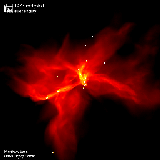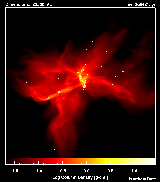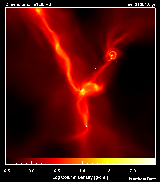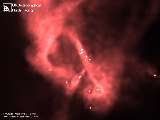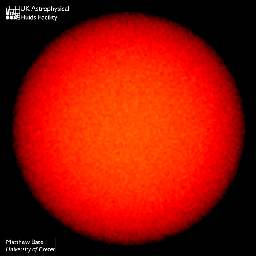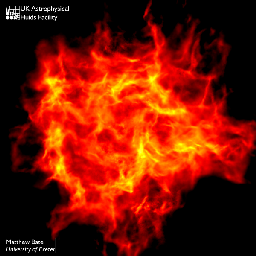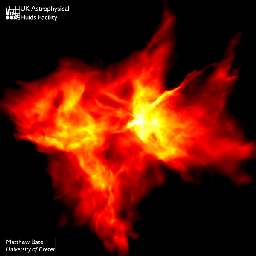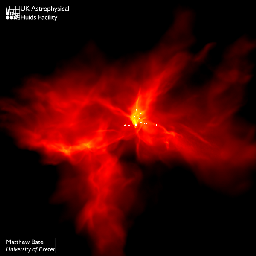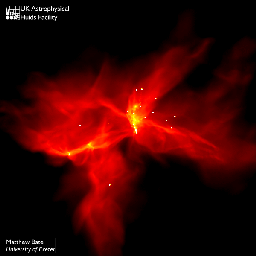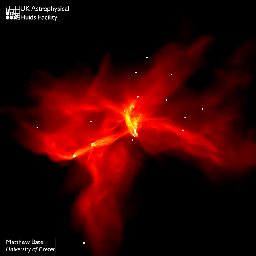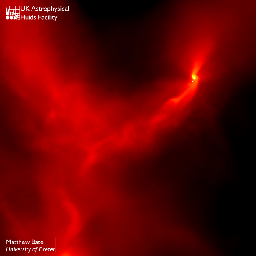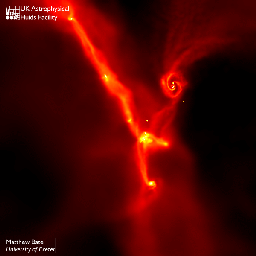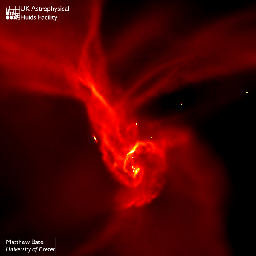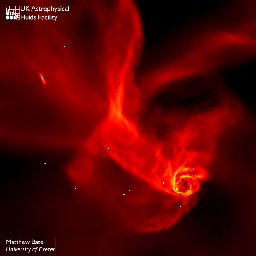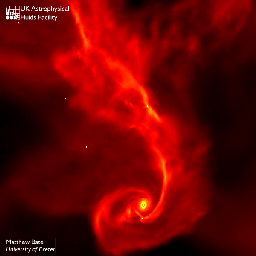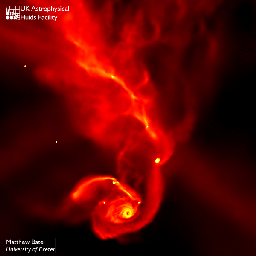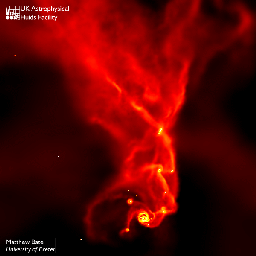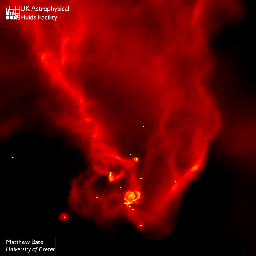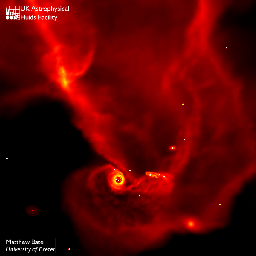The Formation of Stars and Brown Dwarfs and the Truncation of Protoplanetary Discs in a Star ClusterMatthew R. Bate, Ian A. Bonnell, and Volker Bromm AnimationsCopyright: The material on this page is the property of Matthew Bate. Any of my pictures and animations may be used freely for non-profit purposes (such as during scientific talks) as long as appropriate credit is given wherever they appear. Permission must be obtained from me before using them for any other purpose (e.g. pictures for publication in books). Simulation & visualisation by Matthew Bate, University of Exeter unless stated otherwise.
Notes on formats:
Press Release Text (Friday April 12, 2002)
YOUNG STARS IN CHAOSIt is not only teenagers who like to congregate in intimate groups and disturb their neighbours and surroundings. As Matthew Bate (University of Exeter), will be explaining to the UK National Astronomy Meeting in Bristol on Friday 12 April, young stars also like to hang around in crowds and undergo chaotic close encounters with each other during their formative years. After performing one of the largest and most complex simulations of star formation to date, Matthew Bate, Ian Bonnell (University of St Andrews) and Volker Bromm (Harvard-Smithsonian Center for Astrophysics) have found that these cosmic furnaces form in a much more chaotic manner than is generally believed. To perform the calculation, the astronomers used the supercomputer at the United Kingdom Astrophysical Fluid Facility (UKAFF), a national computing facility for astronomy sited at the University of Leicester. The calculation was so enormous that it required 100,000 CPU hours, roughly 10% of the time available on the 128-processor supercomputer during 2001. The simulation followed the collapse of an interstellar gas cloud which was over one light year across and 50 times the mass of the Sun, eventually resulting in the formation of a cluster of 50 stars and brown dwarfs. One of the big surprises found by the astronomers was how chaotic and dynamic the process of star formation is. The results showed that stars form so close together that they often interact with each other well before they have grown to full size. In the small, new-born stellar groups, the stars compete with each other for the remaining gas. This process is inherently unfair, with the more massive stars tending to gather more gas than the lower mass stars, while the lowest mass stars are kicked out of the group. About half of the objects are ejected so quickly that they don't manage to gather enough gas to become stars at all. Rather, they become brown dwarfs, objects with less than 1/13 the mass of the Sun. Unable to generate energy by fusing hydrogen into helium, they cannot continue to shine like the Sun and quickly fade away. The new calculation supports recent astronomical surveys suggesting that there may be as many brown dwarfs as stars in our Galaxy, and indicates that the high frequency of brown dwarfs is a natural consequence of the competition between stars during their formation. Another surprise is that many of the encounters between the stars and brown dwarfs in such clusters are close enough to strip off the outer parts of the dusty discs surrounding the young stars. Although many of the discs are initially very large, by the end of the calculation the majority of them have been truncated to less than the size of our Solar System. Since most stars are believed to form in large star clusters, this suggests that planetary systems like our own may be the exception rather than the rule. Technical DetailsThe calculation models the collapse and fragmentation of a 50 solar mass molecular cloud that is 0.375 pc in diameter (approximately 1.2 light-years). At the initial temperature of 10 K with a mean molecular weight of 2.46, this results in an thermal Jeans mass of 1 solar mass. The free-fall time of the cloud is 190,000 years and the simulation covers 266,000 years. The cloud is given an initial supersonic `turbulent' velocity field in the same manner as Ostriker, Stone & Gammie (2001). We generate a divergence-free random Gaussian velocity field with a power spectrum P(k) \propto k-4, where k is the wave-number. In three-dimensions, this results in a velocity dispersion that varies with distance, lambda, as sigma(lambda) \propto lambda1/2 in agreement with the observed Larson scaling relations for molecular clouds (Larson 1981). This power spectrum is slighly steeper than the Kolmogorov spectrum, P(k)\propto k11/3. Rather, it matches the amplitude scaling of Burgers supersonic turbulence associated with an ensemble of shocks (but differs from Burgers turbulence in that the initial phases are uncorrelated). The calculation was performed using a parallel three-dimensional smoothed particle hydrodynamics (SPH) code with 3.5 million particles on the United Kingdom Astrophysical Fluids Facility (UKAFF). It took approximately 100000 CPU hours running on up to 64 processors. In terms of arithmetic operations, the calculation required approximately 1016 FLOP (i.e. 10 million billion arithmetic operations). The SPH code was parallelised using OpenMP by M. Bate. The code uses sink particles (Bate, Bonnell & Price 1995) to model condensed objects (i.e. the stars and brown dwarfs). Sink particles are point masses that accrete bound gas that comes within a specified radius of them. This accretion radius is to set 5 AU. Thus, the calculation resolves circumstellar discs with radii down to approximately 10 AU. Binary systems are followed to separations as small as 1 AU. Refereed Scientific Papers
"The Formation Mechanism of Brown Dwarfs"
"The Formation of Close Binary Systems by Dynamical Interactions and Orbital Decay"
"The Formation of a Star Cluster: Predicting the Properties of Stars and Brown Dwarfs" High Resolution Still Images and Commentary
High resolution, unannotated (1800x1800 pixel) versions that are suitable for
publication Click on the images below to view medium resolution, annotated (600x600 pixel) versions. Copyright: Matthew Bate, University of Exeter.
| ||||||||||||||||||||||||

